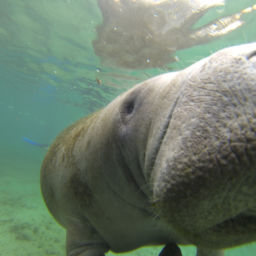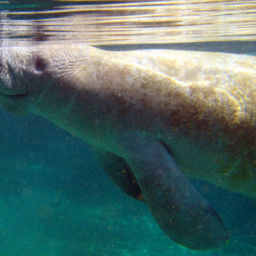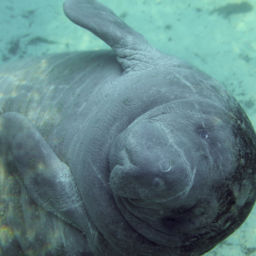There’s something especially endearing about their portly figures and wide, paddle-like flippers, about their whiskered faces and tiny, inquisitive eyes. While their resemblance to the lithe young women of mermaid mythology is hard to see on closer inspection, they nevertheless continue to cast their spell over countless people every year. For many of us, meeting a manatee ranks high on the bucket list and one of the best places to do so in the U.S. is Crystal River, Florida, 70 miles north of Tampa. Crystal River, which connects the springs of Kings Bay with the Gulf of Mexico, sees an influx of the gentle creatures each winter as sea temperatures in the Gulf begin to drop.
Hundreds of manatees seek refuge in the warm waters of Crystal River and Kings Bay, which remain at a constant 72F (22 C) year-round thanks to the hot springs at the river’s head. Unable to tolerate temperatures of less than 68F/20C, the Crystal River manatees depend upon their winter home for warmth. Because of this, certain areas around the springs are protected by the Crystal River National Wildlife Refuge and are off-limits, but outside the perimeters of those sanctuaries it’s possible to snorkel with the manatees on a passive observation basis, wherein the manatee must initiate all interactions.
Although most people think of Florida as a sunny getaway, colder weather is far better for spotting manatees. As the air temperatures drop, more manatees crowd into placid Crystal River where they rest, play and feed in the shallows. During the winter months, several dive centers offer snorkel tours to meet them. Once the manatees have been spotted, the signal is given to slip quietly from the pontoon boats into the water, where visibility can often reach over 100 feet/30 meters depending on the algae in the water.
At first, the silt churned up by the group’s entry clouds our vision but as it settles, the shapes of the day’s first manatees materialize at the edge of visibility. There are four of them, adults of varying sizes that crowd together lazily, as if relishing the comparative warmth of their winter haven. Some of them are heavily scarred victims of boat collisions, and all of their broad bodies are mottled green with algae. With disproportionately small eyes, they observe the intruders into their riverine home, the early morning sunlight casting fractured dapples across the riverbed and the manatees alike. They seem unconcerned by their guests, and after several minutes one of the manatees rises up off the sand and drifts buoyantly closer.
As she approaches, moving in a strange rocking motion with only the slightest tilt of her paddle-like fins, I begin to comprehend just how big these creatures are. These endangered animals can weigh up to 1,320 pounds/600 kilos, and it seems to me as she fills my vision that this one’s among the giants of her species. She is escorted by an entourage of small fish that feed off the algae and parasites living on her skin — thick, wrinkled, gray skin that reminds me that the manatee’s closest land-living relative is the elephant. Stiff hairs fringe her rubbery lips, which curve in such a way that she appears to be smiling. It’s easy to see why manatees are so beloved, and it’s only when the cool water of the river begins to seep in around my snorkel that I realize I’m grinning from ear to ear.
Plenty more manatees appear throughout the course of the morning; large groups of them, resting on their pectorals at the river’s edge; courting couples and even a small calf whose roly-poly body is almost as wide as it is long. Florida manatees are a subspecies of the West Indian manatee, and they are the largest of all extant sirenian species, a group that includes two other manatee species and the dugong. A fifth member of the Sirenian order, the Steller’s sea cow, was hunted to extinction in the 1970s. Tragically, the future of the West Indian manatee is by no means secure, either, and the manatees of Crystal River are now considered endangered.
This iconic species faces manifold threats, many of them caused by the same humans who hold them in such high esteem. Although Crystal River has strict regulations in place to protect manatees from collisions with watercraft, elsewhere the damage done by boat hulls and propellers is a leading cause of manatee mortality. Other causes of death include poisoning as a result of the naturally occurring red tide or toxic plankton bloom that occurs annually in the Gulf of Mexico and off the Florida coast; fatal changes in behavior due to harassment by humans; and a loss of warm water habitats to seek refuge during the winter.
Manatees like those in Crystal River must maintain access to warm-water springs, but human development often results in the loss of these critical habitats. Even in Crystal River, residents are campaigning to have the manatee downgraded from endangered status to vulnerable status so as to stop protective measures from impinging on development plans.
Sustainable and ethical manatee tourism is critical to the future of the Crystal River population. It gives the species considerable economic value. If you visit the Florida manatees, remember that their robust exterior belies their fragile status. Treat them with respect, and never seek uninitiated contact. In this way, the Crystal River manatees will still be around to delight future generations, rather than being consigned to legend like the mermaids they were once thought to resemble.




